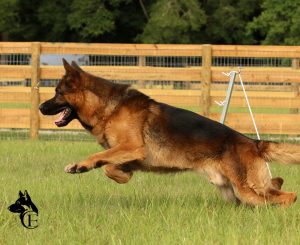When it comes to owning a German shepherd dog, one factor that we all know is that they have thick beautiful coats. With this thick coat comes some upkeep that needs to be done on our end as owners. A common question that we at Canine Extreme get is; what combs and brushes do I use? While this can be based on preference, there are a few standard brushes that will benefit your furry friend. In this article, you will find a brief breakdown of some of the grooming needs that your German Shepherd dog has.
When To Neuter or Spay Your Dog

Early Neutering Poses Health Risks for German Shepherd Dogs, Study Finds
By Trina Wood on May 26, 2016 in Human & Animal Health
Renowned for their intelligence, obedience and loyalty, German shepherd dogs are often the preferred breed for police and military work, as well as popular service dogs and family pets. But as most handlers, breeders and veterinarians are aware, joint disorders are a big concern in these animals.
A new study in the journal Veterinary Medicine and Science finds that neutering or spaying these dogs before 1 year of age triples the risk of one or more joint disorders — particularly for cranial cruciate ligament, or CCL, tears.
“Debilitating joint disorders of hip dysplasia, CCL and elbow dysplasia can shorten a dog’s useful working life and impact its role as a family member,” said lead investigator Benjamin Hart, a distinguished professor emeritus in the UC Davis School of Veterinary Medicine. “Simply delaying the spay/neuter until the dog is a year old can markedly reduce the chance of a joint disorder.”
Dog owners in the United States typically choose to spay or neuter their dogs prior to 6 months of age, in large part to prevent pet overpopulation or hoping to avoid unwanted behaviors. In Europe, however, neutering is generally avoided by owners and trainers and not promoted by animal health authorities, Hart said.
During the past decade, some studies have indicated that spaying or neutering can have several adverse health effects for certain dog breeds. For example, a 2014 study published in PLoS ONE and also led by Hart, examined the health records of over 1,000 golden retrievers and found a surprising fourfold increase in one or more joint disorders associated with spay or neuter before 1 year of age. In the same paper, joint disorders in Labrador retrievers were found to be increased by just twofold in dogs spayed or neutered in the first year.
For this current study, researchers examined veterinary hospital records over a 14.5-year period on 1,170 intact and neutered (including spayed) German shepherd dogs for joint disorders and cancers previously associated with neutering. The diseases were followed through 8 years of age, with the exception of mammary cancer in females, which was followed through 11 years.
The dogs were classified as intact (not neutered), neutered before 6 months, neutered between 6 to 11 months, or neutered between 12 to 23 months and 2 to 8 years. Joint disorders and cancers are of particular interest because neutering removes male and female sex hormones that play key roles in important body processes such as closure of bone growth plates.
Seven percent of intact males were diagnosed with one or more joint disorders, compared to 21 percent of males neutered prior to a year of age.
In intact females, 5 percent were diagnosed with one or more joint disorders, while in females neutered prior to 1 year of age this measure was significantly increased to 16 percent.
Mammary cancer was diagnosed in 4 percent of intact females compared with less than 1 percent in females neutered before 1 year of age. (The occurrence of the other cancers followed through 8 years of age was not higher in the neutered than in the intact dogs.)
Urinary incontinence, not diagnosed in intact females, was diagnosed in 7 percent of females neutered before 1 year of age.
“In addition to dogs suffering pain from joint disorders, the condition may also disqualify the dog as a working partner in military and police work,” Hart said. “We hope these findings provide evidence-based guidelines for deciding the right age to neuter a puppy to reduce the risk of one or more joint disorders.”
Other researchers on this UC Davis study were: Lynette Hart and Abigail Thigpen, School of Veterinary Medicine; and Neil Willits, Department of Statistics.
The research was supported by the Canine Health Foundation and donors to the Center for Companion Animal Health.
Media contact(s)
Benjamin Hart, School of Veterinary Medicine, 530-219-3298, blhart@ucdavis.edu
Trina Wood, School of Veterinary Medicine Dean’s Office, 530-752-5257, tjwood@ucdavis.edu
Pat Bailey, News and Media Relations, 530-219-9640, pjbailey@ucdavis.edu
More Articles
Bathing Your German Shepherd
While nothing can compare with that new puppy smell, sometimes it can take a turn in the wrong direction. Having a German Shepherd in the home can be a memorable experience that brings joy to any household. However, keeping your pup clean and smelling wonderful can be a bit overwhelming at times. Rest assured, this part of owning a german shepherd can be an easy task that can also be enjoyable and a fun time!
How To Read A Canine Extreme Pedigree
Reading a pedigree can be a daunting and even a confusing task at first. Rest assured, there is a pattern to the pedigree that once understood, it becomes much more straightforward. Knowing how to read the pedigree can provide you with valuable information on the dog and their lineage. You can find various information on a dog’s pedigree, such as names, parents, grandparents, date of birth, and titles. Below you will find a Canine Extreme pedigree that has been broken into sections to help read and understand a pedigree: